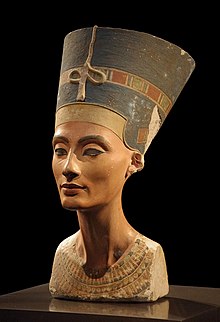Thutmose (sculptor)
| Thutmose | |
|---|---|

Thutmose's bust of Nefertiti, on display at the Neues Museum Berlin
|
|
| Born | 14th Century B.C. |
| Nationality | Egyptian |
| Known for | Sculpture |
| Notable work | Bust of Nefertiti |
| Movement | Amarna art |
| Patron(s) | Pharaoh Akhenaten |
"The King's Favourite and Master of Works, the Sculptor Thutmose" (also spelled Djhutmose and Thutmosis), flourished 1350 BC, is thought to have been the official court sculptor of the Egyptian Pharaoh Akhenaten in the latter part of his reign. A German archaeological expedition digging in Akhenaten's deserted city of Akhetaton, at Amarna, found a ruined house and studio complex (labeled P47.1-3) in early December 1912; the building was identified as that of Thutmose based on an ivory horse blinker found in a rubbish pit in the courtyard inscribed with his name and job title. Since it gave his occupation as "sculptor" and the building was clearly a sculpture workshop, it seemed a logical connection.
Among many other sculptural items recovered at the same time was the polychrome bust of Nefertiti, apparently a master study for others to copy, which was found on the floor of a storeroom. In addition to this now-famous bust twenty-two plaster casts of faces—some of which are full heads, others just the face—were found in Rooms 18/19 of the studio, with an additional one found in Room 14. Eight of these have been identified as various members of the royal family including Akhenaten, his other wife Kiya, his late father Amenhotep III, and his eventual successor Ay. The rest represent unknown individuals, presumably contemporary residents of Amarna.
A couple of the pieces found in the workshop depict images of older noblewomen which is rare in Ancient Egyptian art, which more often portrayed women in an idealized manner as always young, slender and beautiful. One of the plaster faces depicts an older woman, with wrinkles at the corner of her eyes and bags under them, and a deeply lined forehead. This piece has been described as showing "a greater variety of wrinkles than any other depiction of an elite woman from ancient Egypt" It is thought to represent the image of a wise, older woman. A small statue of an aging Nefertiti was also found in the workshop, depicting her with a rounded, drooping belly and thick thighs and a curved line at the base of her abdomen showing that she had borne several children, perhaps to project an image of fertility.
...
Wikipedia
